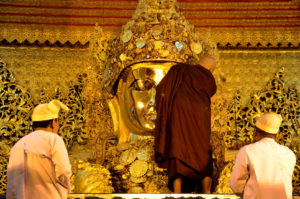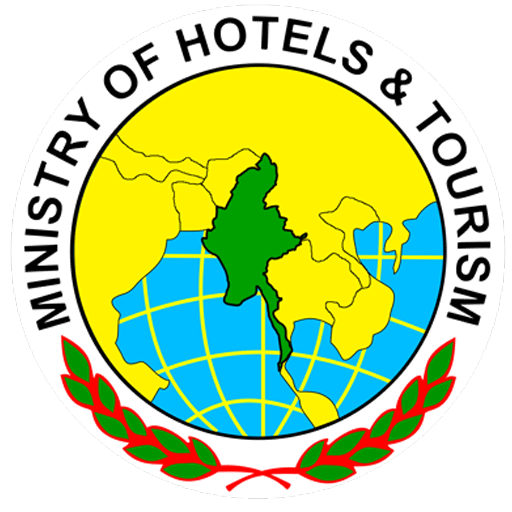The Bronze Image of Buddha
 The art of making Buddha image started only 400 years after the death or Buddha Buddhism and Buddha image sculpture are believed to have come to Myanmar from Amarawati of India. The first Buddha images of Myanmar were excavated in Hmawzar, Kingbagon of Krikshetre in sixth century A.D. They are made of silver and bronze. And the bronze image were also excavated in Waithali of Rakhine in eighth century A.D. They are many bronze images in Myanmar. The famous images are Mahamyatmuni Buddha image in Rakhine, Kyee thun Buddha image in Yangon.
The art of making Buddha image started only 400 years after the death or Buddha Buddhism and Buddha image sculpture are believed to have come to Myanmar from Amarawati of India. The first Buddha images of Myanmar were excavated in Hmawzar, Kingbagon of Krikshetre in sixth century A.D. They are made of silver and bronze. And the bronze image were also excavated in Waithali of Rakhine in eighth century A.D. They are many bronze images in Myanmar. The famous images are Mahamyatmuni Buddha image in Rakhine, Kyee thun Buddha image in Yangon.
 In Myanmar, there are ten kinds of traditional arts and crafts. The art of bronze casting is call Pa-din. The bronze casting has already appeared since Pagan period. Mostly bronze casting can be found in Tampawadi quarter in Mandalay. You can see bronze Buddha images in different positions and different sizes. There are some standing Buddha images in Pagan museum. Four standing bronze Buddha images at the four entrances of ShweZiGon Pagoda in Pagan and Mahamyatmuni image in Mandalay are the outstanding works of Myanmar master craftsmen. Then I’d like to explain you about the procedure of bronze casting. In the first step, the artisan has to mix red earth and hasps or yellow dusts and horse meaner. And pounding them to powder. And making them into a fine clay for moulding. Before casting images in bronze, there must be a mould in which to cast it. The artisan mould the fine clay into the required figures or objects, Moulding the images is an important function for a bronze artist. The artisan has to delineates the right features and expression, determines posture, position and proportions of the image.
In Myanmar, there are ten kinds of traditional arts and crafts. The art of bronze casting is call Pa-din. The bronze casting has already appeared since Pagan period. Mostly bronze casting can be found in Tampawadi quarter in Mandalay. You can see bronze Buddha images in different positions and different sizes. There are some standing Buddha images in Pagan museum. Four standing bronze Buddha images at the four entrances of ShweZiGon Pagoda in Pagan and Mahamyatmuni image in Mandalay are the outstanding works of Myanmar master craftsmen. Then I’d like to explain you about the procedure of bronze casting. In the first step, the artisan has to mix red earth and hasps or yellow dusts and horse meaner. And pounding them to powder. And making them into a fine clay for moulding. Before casting images in bronze, there must be a mould in which to cast it. The artisan mould the fine clay into the required figures or objects, Moulding the images is an important function for a bronze artist. The artisan has to delineates the right features and expression, determines posture, position and proportions of the image.
 In the second step, the artisan plasters the resultant mod with the rough wax with the thick he wants after the core clay cast has already set and hardened. The wax must be ground and flattened. So that it can be plastered evenly on the core clay cast. After plastering by rough wax, the artisan has to plaster again with soft wax. In this time, the artisan shapes the mould by using his skills to the full in plastering the soft surface wax. It is because this surface wax is that will have its impress on the resultant bronze cast. In the third step, the artisan plasters a mixture of fine and rough clay on the wax mould after the soft surface layer wax cast has become hardened. There are three layers of mould for bronze casting. The innermost layer is the core clay cast, and the second layer is a wax cast, and the third layer is a semi-rough clay cast. Before the third layer has hardened, two holds must be bored through the third layer to the second layer at the bottom of the mould. They are for pouring bronze and for melting out the wax Shaping and making mould takes more than a day to complete it. For casting bronze image, a compound of copper and Zinc in the ratio of ten viss of copper to eight viss of zinc is needed. Mixture of copper and zinc gives the cast the colour of gold.
In the second step, the artisan plasters the resultant mod with the rough wax with the thick he wants after the core clay cast has already set and hardened. The wax must be ground and flattened. So that it can be plastered evenly on the core clay cast. After plastering by rough wax, the artisan has to plaster again with soft wax. In this time, the artisan shapes the mould by using his skills to the full in plastering the soft surface wax. It is because this surface wax is that will have its impress on the resultant bronze cast. In the third step, the artisan plasters a mixture of fine and rough clay on the wax mould after the soft surface layer wax cast has become hardened. There are three layers of mould for bronze casting. The innermost layer is the core clay cast, and the second layer is a wax cast, and the third layer is a semi-rough clay cast. Before the third layer has hardened, two holds must be bored through the third layer to the second layer at the bottom of the mould. They are for pouring bronze and for melting out the wax Shaping and making mould takes more than a day to complete it. For casting bronze image, a compound of copper and Zinc in the ratio of ten viss of copper to eight viss of zinc is needed. Mixture of copper and zinc gives the cast the colour of gold.
While the mixture of metal is being melted in the kiln, the mould is also heated in a separated kiln. The reasons are –
- To melt down wax cast in the middle layer of the mould.
- To bake the mould for the bronze casting by melting down the wax cast
- Liquid wax leaves the mould through two holes at the bottom of the mould. So, the middle layer of the mould becomes hollow for casting.

In melting down the wax cast, if the image to be cast is small, the artisans use coal and cow dung slabs for heating, but it is large, they use fire wo
heat. Thus, the mould is baked evenly and good. Over heating under heating or uneven heating must be avoided. The artisans have to pour the molten mixture into one of the two holes at the bottom of the mould until the molten mixture comes out from the other hole. Then they have to stop pouring, having filled the hollow in the middle layer of the mould with molten mixture inside it to cool off. It takes a day or two for completely cooled off.
od. For the use of burning, cow dung slabs give steady
When the mould gas completely cooled off and become solid, the outer layer of the mould must be crushed with a blow or two of the hammer. Some images may have rough or creased patches on their surfaces for which filling is needed to smooth them out. The last step in the process of the bronze casting is using an iron-rod with a pointed hook at the tip to lever out the unwanted bibs and bobs. Finally, they get a good bronze image. If you want to study about the bronze casting, you can visit and study at the Tampawady quarter in Mandalay. You should go in the morning because the bronze Armtek work in the morning time only.





